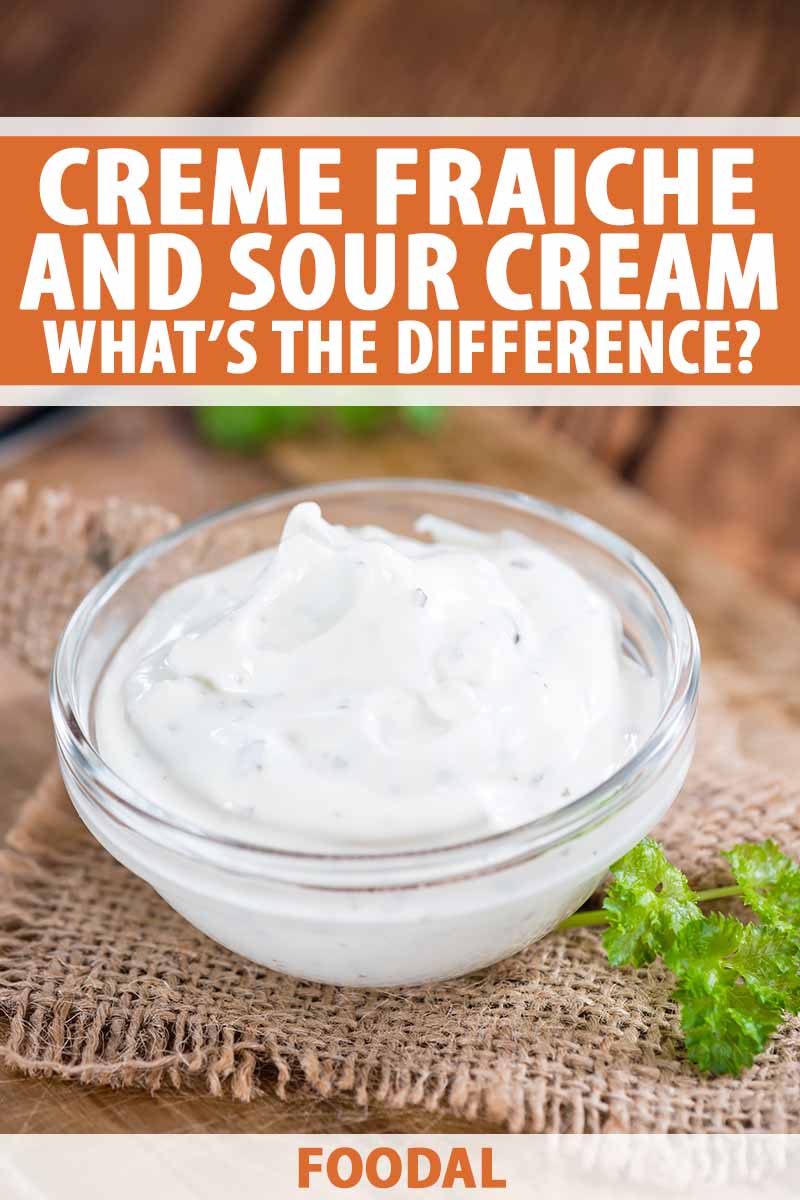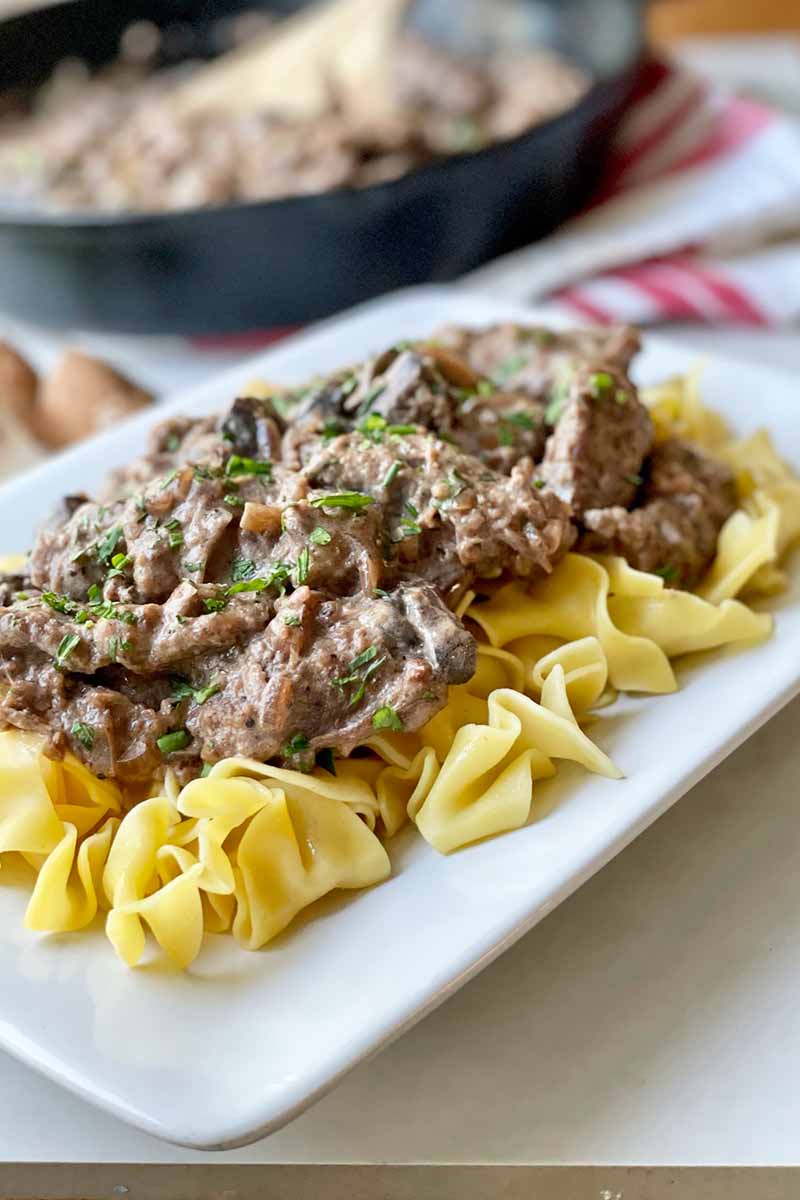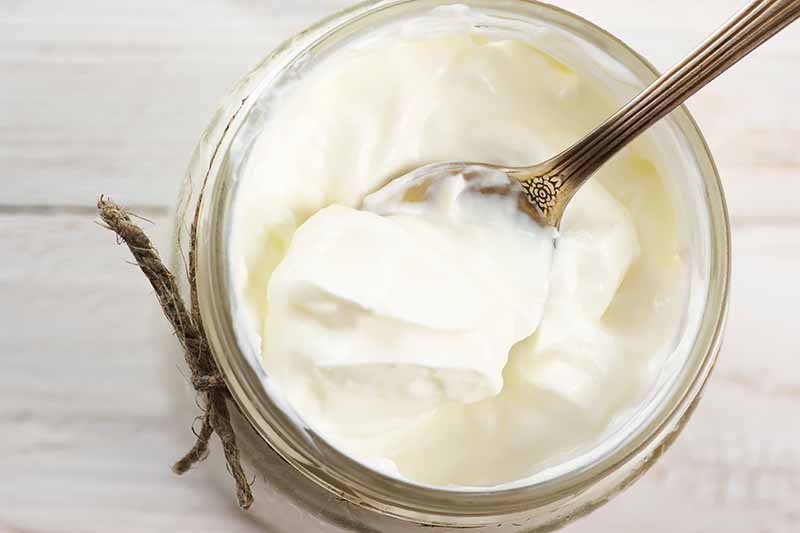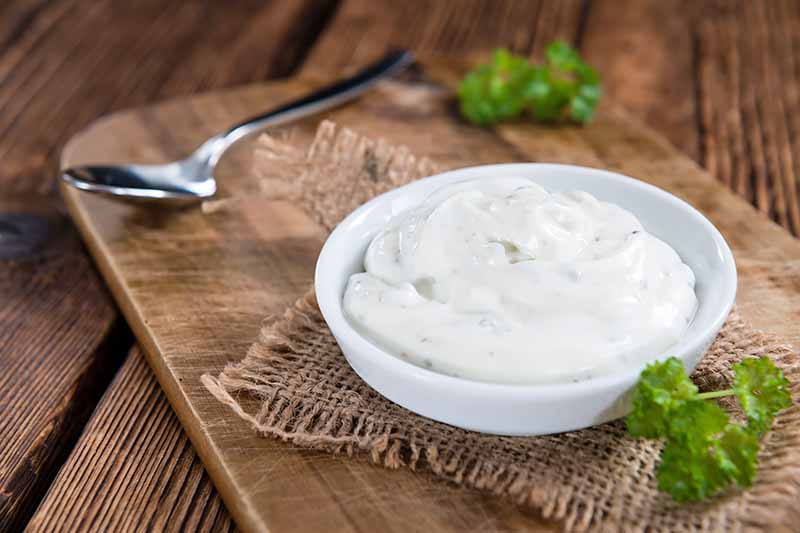Whether you are a novice or proficient home chef, you’re bound to come across ingredients that are unfamiliar from time to time, and to have questions about substitutions.

If you’re like me, with some school-of-life French up your sleeve, you would likely assume that crème fraîche is fresh, and sour cream is, well, sour.
But guess what?
Both are fermented, or cultured, dairy products.
Read on to learn all you need to know about using crème fraîche and sour cream in your kitchen. Here’s what we’ll cover:
What’s the Difference Between Crème Fraîche and Sour Cream?
Bacteria and Butterfat
In a nutshell, heavy cream, aka heavy whipping cream, is the richest part of natural cow’s milk, the part that contains the most butterfat.

It is often sold separately from milk, and is frequently sweetened and beaten into thick mounds for use in sweet confections.
It is also used to make both crème fraîche and the sour variety. In its unpasteurized state, the simple act of leaving heavy cream out overnight activates natural bacteria. These bacteria produce an acid that thickens and sours it.
The process may also be initiated artificially with pasteurized milk, by introducing lactic-acid producing bacteria that are not present in the sterilized milk commonly found in supermarkets around the world.

The sour kind is made in much the same way, but with a ratio of acidifier to dairy that is heavier on the acidifier, for a thinner, slightly more sour product.
Crème fraîche is the richer of the two, with approximately 11 grams of butterfat at 110 calories per ounce, or per 2 tablespoons. It has a slightly acidic pH of 6.2 to 6.3.
Sour cream is lower in calories, with about 5 grams of butterfat and, at 60 calories per ounce, or per 2 tablespoons. It has a more acidic pH of 4.5.
One-for-One
Both types of cultured dairy products are used in a variety of recipes, from soups and savory dishes to toppings and frozen desserts. And while they are not identical, they may be substituted for one another in a 1:1, or cup-for-cup, ratio.

Our beef stroganoff and Guinness Stout chocolate cupcakes with Baileys frosting both call for sour cream, but you can substitute crème fraîche. (Note that while the cupcakes call for a cultured product, the frosting requires the fresh heavy whipping variety.)
Does this mean that any time a recipe calls for crème fraîche, the sour type is a viable alternative?
No, and here’s why:
Crème fraîche has more butterfat and lower acidity, so it can withstand high cooking temperatures and boil without curdling, or separating into clumps.

Sour cream, on the other hand, has less butterfat and higher acidity, so it curdles at high temperatures, and when added too rapidly to hot dishes.
Ways to get around the sour kind’s tendency to separate are to keep the cooking temperature below boiling, and to add it very gradually.
As for cold dishes, you’ll find the two are interchangeable, but crème fraîche is going to be a bit thicker and slightly milder than its sour counterpart.
There are reduced fat versions of both types available, but know that when a recipe calls for a cultured dairy product, full-fat is implied unless otherwise specified. Reduced fat alternatives are thinner and may not produce the desired results.
At this point, we should touch on the subject of clotted cream. This English delight is made by heating and slowly cooling full-cream milk to produce a rich, thick texture with a nutty flavor. It’s wonderful with jam on scones, and in sweet confections.

As there is no fermentation involved, this style of product is not a good substitute in recipes that call for the tangy, cultured flavor of crème fraîche or sour cream.
When shopping for ingredients, be aware that the more butterfat a product contains, the more expensive it is likely to be. Don’t be surprised if you find crème fraîche offered at more than three times the price of its humble sour cousin.
Make Your Own
With pasteurized heavy cream and buttermilk, you can make your own cultured dairy products.

All you need is a sanitary jar or plastic container with a tight-fitting lid, buttermilk, and liquid heavy cream. This is not an exact science, and the required prep time may vary.
For sour cream, add two tablespoons of buttermilk to eight ounces of liquid heavy cream, tighten the lid, shake, and let it sit overnight at room temperature. The process should yield a smooth mixture that spoons into soft mounds and has a refreshingly piquant taste.
For crème fraîche, add one tablespoon of buttermilk to eight ounces of liquid heavy cream, shake well in a jar, and let the mixture sit for up to 24 hours in a temperate room. The final product should be thick and rich when spooned, and pleasantly tart to the palate.
Note that pasteurized heavy cream is preferable to ultra-pasteurized, as it thickens quicker.
And if you’re having trouble locating buttermilk, make your own.
In a jar or container with a tight-fitting lid, combine 1 cup of whole milk with 1 tablespoon of either lemon juice or white vinegar. Shake well and let the mixture sit for 10 minutes before using.
All three of these home-prepared dairy foods should keep for at least one week in the refrigerator, thanks to the preservative properties of the acid produced by the bacteria. Discard them if they separate, become discolored, or smell off.
Some folks freeze these dairy foods, but there may be some expansion during freezing, and there is likely to be separation during thawing, so we do not recommend it.
Dolloping with Discretion
Now that you know the similarities and differences between crème fraîche and its sour counterpart, you can tackle recipes that call for them with confidence.

To recap:
Crème fraîche is thicker, higher in calories, stable at high temperatures, and more expensive. The flavor is lower in acidity and pleasantly tangy. You may have to seek out a specialty store for this product, or you can make your own.
The sour variety is thinner, lower in calories, unstable at high temperatures, and affordable. It’s more acidic, has a more sour taste, and is readily available. You can also craft your own.
You may find both easier to digest than unfermented dairy products.
And by the way, if you’re ever in France and looking for a fresh dairy product to whip, just ask for crème liquide.
If you found learning about these types of cultured dairy products informative, we recommend reading these articles next:
- A Sweet Guide to Sugar: Different Types and How to Use Them
- The 6 Most Common Fresh Cheese Varieties for Every Occasion
- The Wonderful World of Vegetable Oils; Varieties, Flavor, and Uses for the Home Cook
Photo by Fanny Slater, © Ask the Experts, LLC. ALL RIGHTS RESERVED. See our TOS for more details. Uncredited photos via Shutterstock.
About Nan Schiller
Nan Schiller is a writer from southeastern Pennsylvania. When she’s not in the garden, she’s in the kitchen preparing imaginative gluten- and dairy-free meals. With a background in business, writing, editing, and photography, Nan writes humorous and informative articles on gardening, food, parenting, and real estate topics. Having celiac disease has only served to inspire her to continue to explore creative ways to provide her family with nutritious locally-sourced food.





In the recipe for sour cream versus the creme fraiche The only difference was an extra tablespoon of buttermilk. How does this account for the fat differences you mentioned earlier on in the article, sour cream having 5 grams of fat versus creme fraiche having 11 grams of fat, according to the nutrition information you posted?
Hi Jeanne –
Thank you for your excellent question.
Homemade and commercial products may vary in their fat content, not because of the ratio of buttermilk to cream, but because of the fat content of the cream used to make them.